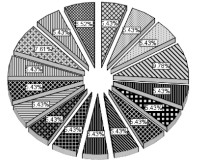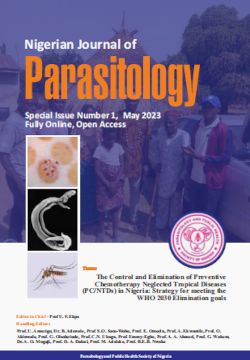Helminth Infections of Captive Animals and Management Practices at the University of Ilorin Zoo, North-Central, Nigeria
https://dx.doi.org/10.4314/njpar.v43i2.2
Keywords:
management practices, zoo, helminths, PrevalenceAbstract
This study investigated the helminth parasites of animals and management practices at the University of Ilorin Zoological garden. Faecal samples were collected and analysed according to standard parasitological techniques while information on management practices was obtained using a structured questionnaire. The overall prevalence of helminths was 20.7%. Three parasites namely, Ascaris spp., Trichostrongylus spp. and Enterobius spp. were identified. Of the 92 animal faecal samples examined, common jackal (21.1%), crested porcupine (42.1%), Lioness (15.8%), and mongoose (21.1%) were positive (p<0.05). Only mammals were positive for intestinal helminth while Aves were not infected (p>0.05). Animals fed three times a week had higher helminth infection (57.9%) when compared with animals fed daily (42.1%). Cages cleaned daily had more helminth parasite contamination (78.9%) compared to those cleaned weekly (21.1%, p<0.05).Also, animals dewormed on monthly basis harboured fewer intestinal helminths (5.3%), compared to those dewormed every three months (78.9%, p>0.05). Surprisingly, animals in enclosures with cemented floors had the highest helminth infection (78.9%) compared to those living in enclosures with uncemented floor (p<0.05). The overall prevalence of helminths is low in this study; therefore, zoo workers should take more cognizance of the routes of parasite transmission, since the faecal-oral route is the primary means through which animals acquired infection. There is a need for improved management practices to curb the spread of helminth infection. This will invariably ensure the sustainability of zoological gardens.
References
IUCN (2019). Changes in numbers of species in the threatened categories (CR, EN, VU) from 1996 to 2018 (IUCN Red List version 2019-1) for the major taxonomic groups on the Red List 2018.Available from: https://wwwiucnredlistorg/resources/summary-statistics
Frost, W. (2011). Zoos and Tourism. Channel View Publications; Bristol.
Akpan, P., Abraham, J. and Ekwetiong, P. (2010). Survey of gastro-intestinal parasites of chimpanzees and drill monkeys in Drill Ranch, Calabar, Cross River State, Nigeria. African Research Review 4(3a):334-40.
Kashid, K. P., Shrikhande, G. B. and Bhojne, G. R. (2003). Incidence of gastrointestinal helminth in captive animals at different location. Zoos’ Print Journal 18(3):1053-4.
Stoner, K. (1996). Prevalence and intensity of intestinal parasites in mantled howling monkeys (Alouatta palliata) in Northeastern Costa Rica: Implications for conservation biology. Conservation Biology 10(2):539–46.
Atanaskova, E., Kochevski, Z., Stefanovska, J. and Nikolovski, G. (2011). Endoparasites in wild animals at the zoological garden in Skopje, Macedonia. Journal of Threatened Taxa 3(7):1955–8.
Opara, M., Osuji, C. and Opara, J. (2010). Gastrointestinal parasitism in captive animals at the zoological garden, Nekede Owerri, Southeast Nigeria. Report and Opinion 2(5):21-8.
Ajibade, W., Adeyemo, O. and Agbede, S. (2010). Coprological survey and inventory of animals at Obafemi Awolowo University and University of Ibadan Zoological garden. World Journal of Zoology 5(4):266-71.
Thawait, V. K., Maiti, S. and Dixit, A. A. (2014). Prevalence of gastro-intestinal parasites in captive wild animals of Nandan Van Zoo, Raipur, Chhattisgarh. Veterinary World 7(7):448-451.
Kolapo, T. and Jegede, O. (2017). A survey of gastrointestinal parasites of captive animals at the University of Ilorin Zoological Garden. Vom Journal of Veterinary Science 12:17-27.
Otegbade, A. and Morenikeji, O. (2014). Gastrointestinal parasites of birds in zoological gardens in south-west Nigeria. Tropical Biomedicine 31(1):54–62.
Ajibade, W., Adeyemo, O., Agbede, S. (2010). Coprological survey and inventory of animals at the Obafemi Awolowo University and University of Ibadan zoological gardens. World Journal of Zoology 5(4):226-71.
Raja, M., Dey, A., Begum, N., Kundu, U. and Ashad, F. (2014). Coprological study of
gastrointestinal parasites of carnivores and small aniamls at dhakal zoo. Journal of Threatened Taxa 6(3):5574-9.
Papini, R., Girivetto, M., Marangi, M., Mancianti, F. and Giangaspero, A. (2012). Endoparasite infections in pet and zoo birds in Italy. The Scientific World Journal 12:1-9.
Lim, Y., Ngui, R., Shukri, J., Rohela, M. and Mat-Naim, H. (2008). Intestinal parasites in various animals at a zoo in Malaysia. Veterinary Parasitology 157:154- 9.
Gurler, A., Beyhan, Y., Acici, M., Bolukbas, C. and Umur, S. (2010). Helminths of mammals and birds at the Samsun zoological garden, Turkey. Journal of Zoo and Wildlife Medicine 41(2):218–23.
Mañas, E., Ortiz, J., Espeso, G., Juan, M., Benzal, J., Ibáñez, B., et al. (2019). Survey of husbandry practices for bovidae in zoos: the importance of parasite management for reintroduction programmes. Veterinary Record 9:1-6..

Downloads
Published
How to Cite
Issue
Section
License
Copyright (c) 2023 Nigerian Journal of Parasitology

This work is licensed under a Creative Commons Attribution-NonCommercial-NoDerivatives 4.0 International License.




